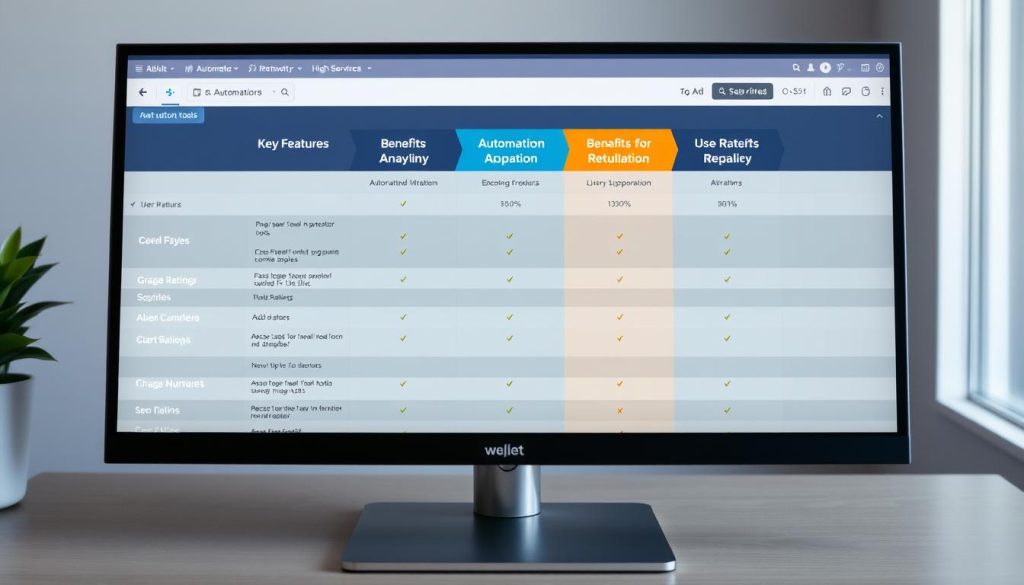The world of marketing automation is rapidly evolving. According to Demand Sage, a staggering 80 percent of advertising could be automated by late 2023. With 58 percent of marketers already leveraging these powerful tools, it’s clear that automation is revolutionizing the industry.
We’re cutting through the noise to deliver what matters most: automated content marketing solutions that maximize your return on investment. By harnessing the power of automation, businesses can streamline their workflows, boost results, and unlock new potential.
Key Takeaways
- Discover how marketing automation can transform your entire content strategy
- Learn how to implement automation tools that align with your business goals
- Understand the benefits of comprehensive content marketing automation
- Find out how to reduce marketing spend while improving customer engagement
- Gain a clear roadmap for implementing automated content marketing solutions
Understanding Automated Content Marketing
In today’s fast-paced digital landscape, understanding automated content marketing is crucial for success. We are constantly looking for ways to optimize our marketing efforts, and automation is at the forefront of this endeavor.
What Is Content Marketing Automation?
Content marketing automation refers to the use of software to automate repetitive and time-consuming tasks in the content marketing process. This allows marketers to focus on more strategic and creative work. Automation tools can handle tasks such as publishing content on social media, analyzing blogging data analytics, and managing editorial calendars.
By leveraging these tools, businesses can streamline their content marketing process, making it more efficient and less prone to human error. For instance, automation tools can help in scheduling content in advance, ensuring consistency across all marketing channels.

How Automation Transforms Your Marketing Strategy
Automation significantly transforms your marketing strategy by enabling the publication of content at optimal times, even when you’re not available to manually post. This ensures that your audience receives a consistent flow of content, enhancing engagement and brand visibility.
| Marketing Task | Manual Effort | Automated Effort |
|---|---|---|
| Content Publishing | High | Low |
| Data Analysis | High | Low |
| Editorial Scheduling | High | Low |
By automating routine tasks, marketers can focus on high-value creative work, such as developing a more effective content marketing strategy. This not only improves productivity but also enhances the overall quality of the content being produced.
The Business Impact of Content Marketing Automation
Automating content marketing can revolutionize your business operations. By streamlining content creation and distribution, businesses can achieve significant efficiency gains and improve their overall marketing performance.

Time and Resource Efficiency
One of the primary benefits of content marketing automation is the reduction in time and resources required to manage content. According to marketing consultant Brian Honigman, producing a 3,000 or 4,000-word blog post can take several weeks, encompassing ideation, drafting, editing, and posting. By automating tasks such as scheduling, formatting, and basic distribution, businesses can save 30-40% of their marketing team’s time, allowing them to focus on strategic initiatives.
Improved Productivity and Consistency
Automation not only saves time but also enhances productivity and ensures consistency in content delivery. With automated workflows, businesses can produce high-quality content at scale without increasing their resources. Moreover, automation ensures that content is posted consistently, even during team vacations or unexpected absences, maintaining a steady flow of content to engage the audience.
Data-Driven Decision Making
Data-driven decision making is another significant advantage of content marketing automation. Automated analytics provide real-time insights into content performance, revealing audience preferences and content performance patterns that might otherwise go unnoticed. This enables businesses to make faster optimization decisions, improving their overall marketing results.
By leveraging content marketing automation, businesses can achieve a measurable impact through reduced costs and improved marketing outcomes. As automation continues to transform the marketing landscape, businesses that adopt these technologies will be better positioned to achieve their goals and drive growth.
Key Benefits That Boost Your ROI
By leveraging automated content marketing solutions, businesses can significantly enhance their return on investment. The strategic use of marketing automation not only streamlines processes but also amplifies the impact of their marketing campaigns. This section delves into the specific advantages that contribute to a higher ROI.
Reduced Marketing Spend
One of the most significant benefits of marketing automation is the reduction in marketing spend. By automating routine tasks, businesses can achieve an average reduction of 12% in their marketing expenses. This saving can then be reallocated to high-impact initiatives, further boosting ROI.

Enhanced Customer Engagement
Automation enables sophisticated content personalization at scale, dramatically improving engagement metrics without increasing production costs. By tailoring content to specific audience segments, businesses can foster a deeper connection with their audience, leading to enhanced customer engagement.
Consistent Content Publishing
Consistency is crucial for the success of any content marketing strategy. Automation ensures that content is published consistently, maintaining a reliable schedule that builds audience trust and favors platform algorithms. This consistency is key to keeping your brand top of mind.
Higher Conversion Rates
Automating the nurturing process through targeted content and email marketing campaigns can significantly enhance conversion rates. By pushing leads through the sales funnel more efficiently, businesses can achieve higher conversion rates without additional resource investment.
These benefits collectively contribute to a compounding ROI effect, transforming content from a cost center to a profit-generating asset. By embracing automation in their marketing strategy, businesses can experience a significant boost in their ROI, driving success and growth.
How To Implement Automated Content Marketing
Effective automated content marketing requires a strategic approach. To get the most out of your automation efforts, you need to set clear goals, choose the right tools, create efficient workflows, and continuously measure and optimize your performance.
To start, it’s essential to understand that marketing automation is only as effective as the person programming the software. Therefore, having a clear guide on using content marketing automation is crucial.
Setting Clear Automation Goals
Before diving into automation tools, define your marketing objectives. What do you want to achieve through content marketing automation? Whether it’s increasing your post reach, publishing content more consistently, or engaging with more of your audience, your goals will guide your automation strategy.
Selecting the Right Automation Tools
With your goals in mind, the next step is to select the appropriate automation tools. For instance, if you’re looking to cross-post blog content on Facebook, you’ll need a tool that can handle social media automation. Consider tools that integrate well with your existing tech stack and meet your specific needs. You can explore more about content marketing to understand how different tools can be utilized.

Creating Effective Automation Workflows
Once you’ve chosen your automation tool, it’s time to create workflows. This involves segmenting your audience and setting up rules based on the “if/then” logic. For example, if a user engages with a particular piece of content, then trigger a specific action, such as sending a follow-up email. Many automation platforms allow you to drag and drop elements to create these workflows, making the process efficient.
Measuring and Optimizing Performance
Finally, it’s crucial to measure the performance of your marketing campaigns and automation efforts. Track relevant metrics to understand what’s working and what isn’t. Use this data to continuously refine your automation workflows and improve your overall content marketing strategy.
Top Content Marketing Automation Tools
Elevating your content marketing game requires the best automation tools. With so many options available, choosing the right ones can be daunting. We’ve curated a selection of top content marketing automation tools to help you streamline your marketing efforts and boost ROI.
Content Creation and Management Tools
Effective content creation and management are crucial for a successful content marketing strategy. Tools like HubSpot and Grammarly can help you create, manage, and optimize your content with ease.
HubSpot’s Marketing Hub offers a comprehensive workflow builder that allows you to automate entire marketing campaigns through visual interfaces. With features like form and email automation, you can broaden your content marketing campaigns and improve engagement.

Grammarly, on the other hand, is a powerful tool for enhancing content quality. With its automated suggestions for grammar, tone, and engagement improvements, you can refine your content to resonate with your audience.

Social Media Automation Platforms
Social media automation platforms can help you schedule, cross-post, and track performance across multiple channels simultaneously. By automating your social media management, you can save time and increase your online presence.
Some top social media automation platforms include tools that integrate with various social media channels, allowing you to manage your campaigns from a single dashboard.

Email Marketing and Analytics Solutions
Email marketing automation solutions can help you segment audiences, trigger personalized content delivery, and track engagement metrics without manual intervention. By leveraging these tools, you can optimize your email marketing campaigns and improve conversion rates.
Some top email marketing automation solutions offer advanced analytics and insights to help you refine your content strategy and maximize ROI.

Best Practices for Successful Content Automation
To achieve success with content automation, it’s crucial to follow best practices that enhance your marketing strategy. The key to successful content automation lies in understanding and applying proven best practices that maximize ROI and engagement.
By implementing these strategies, marketers can ensure that their automated content resonates with their target audience and drives meaningful results. We will explore three critical areas: personalization, balancing automation with human touch, and scaling your automation efforts.
Personalization in Automated Content
Personalization is a critical component of effective content automation. By tailoring your content to specific audience niches, you can increase engagement and conversion rates. For instance, a small HVAC company could create a beginner’s guide for first-time customers and a detailed guide for long-term audience members. This level of personalization demonstrates that you understand and care about your audience’s pain points.
To achieve this, you can use segmentation strategies to deliver targeted content that resonates with specific user needs and interests. By doing so, you can maintain authentic personalization within automated content systems, ensuring your audience feels a genuine connection despite the efficiency gains.

Balancing Automation with Human Touch
While automation tools can streamline your content creation process, it’s essential to strike a balance between automation efficiency and human touch. Certain content elements, such as brand storytelling and emotional connections, require human oversight to build trust and emotional resonance with your audience.
By evaluating your content strategy and identifying areas where human touch is necessary, you can ensure that your automated content is both efficient and effective. Our team can help you determine which content elements should receive human oversight and which can be safely entrusted to automation tools.
| Content Element | Human Oversight | Automation |
|---|---|---|
| Brand Storytelling | Yes | No |
| Product Descriptions | No | Yes |
| Social Media Posts | Partial | Yes |
Starting Simple and Scaling Gradually
When implementing content automation, it’s essential to start simple and scale gradually. Begin with basic automation workflows and gradually move to more complex systems as your team builds confidence. This approach allows you to evaluate the effectiveness of your automation tools and make adjustments as needed.
By starting small and scaling gradually, you can ensure a smooth transition to automated content marketing and maximize your ROI. We recommend evaluating free trials and demos strategically to find automation tools that truly fit your team’s workflow and technical capabilities.
Conclusion
The power of automation can transform your content marketing efforts. By implementing the right automation tools and workflows, you can streamline your content operation, achieving a higher ROI with fewer resources. We’ve shown you how to balance automation efficiency with human creativity, ensuring both scale and authenticity. With a clear roadmap for implementation, you’re now equipped to leverage automation for personalized content delivery that resonates with your audience. The future of content marketing belongs to teams that harness automation effectively.
